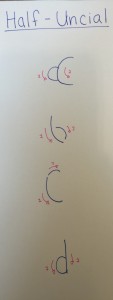Uncial / Half-Uncial (Historical Background and How to)
This section will discuss uncial and half-uncial (also can be referred to as semi-uncial) lettering regarding Latin Palaeography as well as provide a guide on how to write each letter.
Uncial
Uncial lettering is a modification that stems from Old Roman Cursive. There are five distinct letters that move away from a square type of writing and have curved forms. These letters are "A", "D", "E", "H", and "M" as seen in Image I in respective order.

One of the examples that exist today is currently in the Vatican Library. It is a palimpsest fragment of Ciceros' De Republica (4th century). It is shown in Image II below. In this image we see that a lot of the letters are similar to that of the capitalis script but the curves of some of the letters such as "M" and "D" make it characteristic to that of the uncial script.

Image III shows another example but from the 5th century and it is a copy of the work of Livy.

This text seems to be a bit broader than that we see in the rustic capitalis script. The script shown in Images I and II are all written on a 90 degree angle.
Half-Uncial

Half-uncial is one of the scripts that emerged from the New Roman Cursive. One of the most important characteristics of half-uncial is that it is now minuscule. For example: the letter "D" now has an ascender and the letter "P" now has a descender. The uniformity in the length of each letter has disappeared. An example can be seen in Image V.

However, in the later half-uncial, which can be dated from around late antiquity to the early middle ages, we see definite characteristic letters. If we compare them to the uncial writing, the letters that differ the most are: A, B, D, E, F, G, M, P, Q, R, S, and T. Out of all of those, the most difficult to differentiate are R, F, and S. If you look below, there are examples of both the uncial alphabet and the half-uncial alphabet.
Half-uncial was not as popular as uncial, but it was still commonly used in Italy, Spain, and France.
Uncial vs. Half-Uncial


The two images above, show all of the letters in the uncial and half-uncial script side-by-side. You can now visualize the differences between two of the scripts.
How to write in the Uncial Script
How to write in the Half-Uncial Script
Works Cited:
Bischoff, Bernhard. Latin Palaeography: Antiquity and the Middle Ages. Cambridge: Cambridge University Press, 1990.
Cavallo, Guglielmo. “Greek and Latin Writing in Papyri.” In The Oxford Handbook of Papyrology, edited by Roger S. Bagnall, 128-34. Oxford: Oxford University Press, 2011.
Reynolds, L.D., and N.G. Wilson. Scribes and Scholars: A Guide to the Transmission of Greek and Latin Literature. Oxford: Clarendon Press, 1974.
Thompson, Edward Maunde. A Handbook of Greek and Latin Palaeography. Chicago: Argonaut, 1966.










Thank you for sharing this. Research is limited in this field, as you know.
Are half-uncials minuscules? There appear to be many majuscules. My understanding was that the main difference between uncials and half-uncials was their size, from one Roman inch (uncia) to half an inch set on four horizontal lines rather than only two baselines.
Thanks you.
The Majuscule script had all the letters of even size, so between two lines, whereas minuscule scripts had them with ascenders and descenders, so between four lines. Hope that helps 🙂
I don't believe there is a direct connection between New Roman Cursive and Half-Uncial. A more widely accepted statement is that Uncial was a Latin form of Greek Uncial, and Half-Uncial had both features of Uncial and New Roman Cursive. Also, Eastern Roman Empire kept Greek Unical in their manuscripts, especially titles that require Majuscules. However, it is interesting to see some Byzantine manuscripts were written in Greek formed New Roman Cursive.
I have a friend with close to 200 old French documents, many on vellum and done in uncial script. He would like to find someone who could translate some of these that date to 1500-1600. The challenge apparently is finding someone who is not only fluent but able to read the uncial script. I stumbled on this site as we were discussing this tonight. He has scanned all the documents so would be able to send electronic files. Is there anyone on your staff or that you know of capable of translating some of these? Thank you!
Getting me through my class. Thanks.
Pingback: Calligraphy Collections: The History of an Almost Lost Art - WorthPoint
Pingback: Calligraphy Collections: The Historical past of an Nearly Misplaced Artwork – I Class Fr
Pingback: Best Uncial Fonts - Find Your Font